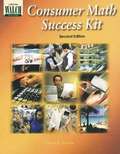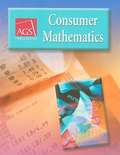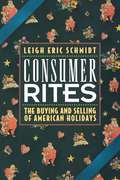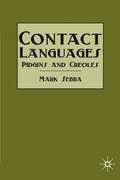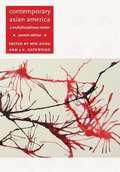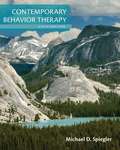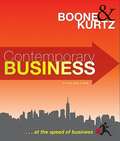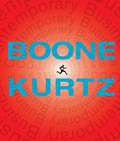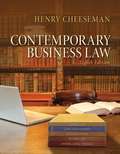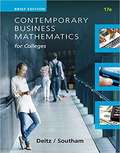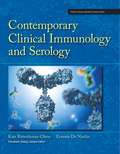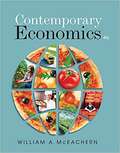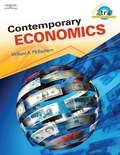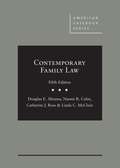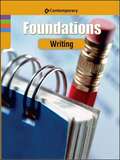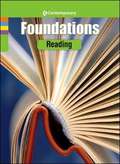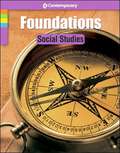- Table View
- List View
Consumer Math
by Larry D. Lemon Larry L. HallPrepare your students for making financial decisions with instruction about credit card charges, taxes, interest on loans and savings, personal banking, and costs of transportation, food, clothing, utilities, insurance, and filling out income tax forms. Being a good steward of the Lord's money is the primary emphasis. The student text presents concepts with numerous examples and step-by-step explanations. Each section contains five cumulative review problems, and each chapter contains a chapter review.
Consumer Math Success Kit, Second Edition
by David E. NewtonThe book helps students understand the terminology of consumer mathematics. Interest rates, prices, tax tables, and new nutrition information have been incorporated into the new edition.
Consumer Mathematics
by Kathleen M. HarmeyerWelcome to Consumer Mathematics. This book includes many of the math skills that you will need now and later in life. Why do you need these skills? Think about the world of mathematics around you. When you buy something, you use math to count money. When you measure something, you use numbers to calculate units of measurement. Buying food, paying taxes, banking, and managing a household all require at least some sort of math.
Consumer Mathematics
by Kathleen M. HarmeyerThis book on Consumer Mathematics will be very useful for day-to-day dealings. The chapters included are: Earning Money, Buying Food, Shopping for Clothes, Managing a Household, Buying and Maintaining a Car, Working with Food, Improving your Home, Traveling, Budgeting your Money, Banking and Investing, Paying Taxes, and Preparing for Careers
Consumer Rites: The Buying and Selling of American Holidays
by Leigh Eric SchmidtSlogans such as "Let's put Christ back into Christmas" or "Jesus is the Reason for the Season" hold an appeal to Christians who oppose the commercializing of events they hold sacred. However, through a close look at the rise of holidays in the United States, Leigh Schmidt show us that commercial appropriations of these occasions were as religious in form as they were secular. The rituals of America's holiday bazaar that emerged in the nineteenth century offered a luxuriant merger of the holy and the profane--a heady blend of fashion and faith, merchandising and gift-giving, profits and sentiments, all celebrations of a devout consumption. In this richly illustrated book, which captures both the blessings and ballyhoo of American holiday observances for the mid-eighteenth century through the twentieth, the author offers a reassessment of the "consumer rites" that various social critics have long decried for their spiritual emptiness and banal sentimentality.
Consumer Society: Critical Issues & Environmental Consequences
by Barry SmartWhat factors are contributing to the continuing growth in consumption of goods and services? At what point do the costs associated with consumerism begin to call our way of life into question? How are the problems of resource depletion, waste and pollution, and environmental impact being addressed? What is to be done about the consequences of our all-consuming way of life?<P> Ever-increasing consumption and a relentless pursuit of growth in output are the twin pillars on which the modern economy and contemporary social life rest. But the consumer way of life is globally unsustainable. We can't all live the consumer dream. <P> This comprehensive, lively and informative book will quickly be recognized as a benchmark in the field. It brings together a huge set of resources for thinking about the development of consumer culture, its defining features, and global consequences. <P> Adept in handling a complex range of classical and contemporary theoretical sources, the book draws on an impressive range of comparative material and provides a variety of contemporary examples to inform and enhance understanding of our consuming way of life. Smart writes with verve and feeling and has produced a stimulating book that enlarges our understanding of consumer culture and provides a timely critical analysis of its consequences.<P> Clear, engaging, and original this book will be essential reading for all those interested in and concerned about our global culture of consumption including researchers and students in sociology, politics, cultural studies, economics, and social geography.
Contact Languages: Pidgins and Creoles
by Mark SebbaIn the last three decades, the field of pidgin and creole studies has become recognized as central to modern linguistics. Designed for the student without previous knowledge of the field, this book builds chapter by chapter to give a compregensive overview of current thinking and research on pidgins and creoles.
Contemporary Asian America: A Multidisciplinary Reader (Second Edition)
by Min Zhou J. V. GatewoodWhen Contemporary Asian America was first published, it exposed its readers to developments within the discipline, from its inception as part of the ethnic consciousness movement of the 1960s to the more contemporary theoretical and practical issues facing Asian America at the century's end. This new edition features a number of fresh entries and updated material. It covers such topics as Asian American activism, immigration, community formation, family relations, gender roles, sexuality, identity, struggle for social justice, interethnic conflict/coalition, and political participation. As in the first edition, Contemporary Asian America provides an expansive introduction to the central readings in Asian American Studies, presenting a grounded theoretical orientation to the discipline and framing key historical, cultural, economic, and social themes with a social science focus. This critical text offers a broad overview of Asian American studies and the current state of Asian America.
Contemporary Behavior Therapy
by Michael SpieglerThis comprehensive, respected, and up-to-date survey of contemporary behavior therapy synthesizes the clinical, research, theoretical, and ethical facets of behavior therapy. Serving as both an introduction for novices and as a scholarly review and resource for more experienced users, CONTEMPORARY BEHAVIOR THERAPY, Sixth Edition covers all the major behavioral and cognitive therapies. The wealth of case studies illustrates the application of behavior therapy techniques to a wide array of problems and clinical populations. The book's multidisciplinary approach includes applications to diverse fields, including psychology, education, social work, nursing, and rehabilitation.
Contemporary Business (14th Edition)
by Louis E. Boone David L. KurtzContemporary Business 14th Edition gives students the business language they need to feel confident in taking the first steps toward becoming successful business majors and successful business people. With new integrated E-Business context throughout the text, it provides a new approach. Another addition is the "Green Business" boxes in every chapter to provide student's with more Green Business information. All of the information provided is put together in a format easy for all students to understand, allowing for a better grasp of the information.
Contemporary Business (Fifteenth Edition)
by David L. KurtzBoone and Kurtz, "Contemporary Business 15th Edition" delivers solutions at the speed of business. Solutions designed to help you improve critical thinking--from the Boone and Kurtz Student Case Videos to the Weekly Updates news blog--will get students thinking, talking, connecting and making decisions--at the speed of business. Experience a textbook program that supports your goals to stimulate curiously, show relevance, promote creativity and prepare students for what's ahead, in their academic and business careers.
Contemporary Business Law
by Henry R. CheesemanPrimarily a text for courses in Business Law, Contemporary Business Law can also serve as a handy resource/reference for newcomers to the world of business. #65533; Take students beyond rote memorization and into true understanding of the concepts and their implications. #65533; This motivating, up-to-date text presents business law, ethics, and the legal environment in a way that intrigues students, spurs them to ask questions, and takes them beyond rote memorization as they learn the issues and concepts. With its emphasis on covering online law and e-commerce as key parts of the legal environment--as well as today's social, ethical, and international issues that are important to the study of business law--it's the ideal text for your one- or two-semester undergraduate course in Business Law. #65533; This text provides a better teaching and learning experience--for you and your students. Here's how: Tailor the material to your specific course with the Custom Database option. Draw students into the material with a rich selection of cases. Address issues critical to the field of business law today.
Contemporary Business Mathematics for Colleges
by James DeitzPresenting a basic, arithmetic-based approach, CONTEMPORARY BUSINESS MATHEMATICS FOR COLLEGES, 17E uses step-by-step development of concepts, hands-on practice exercises, and real-world applications to effectively prepare students for careers in business. Practical skill-building activities are emphasized throughout as the book progresses, from the most basic to more complex business math topics. Numerous problems and examples are taken from actual businesses. In addition, self-check features such as end-of-section Concept Checks, end-of-chapter Bottom Lines, and end-of-chapter Review Problems enable students to test their understanding before advancing to other topics or assignments.
Contemporary Chemistry: The Physical Setting
by Paul S. Cohen Saul L. GeffnerContemporary Chemistry: The Physical Setting is an introduction to the study of chemistry, which follows the New York State Core Curriculum. With this book, you can gain a firm understanding of the fundamental concepts of chemistry--a base from which you may confidently proceed to further studies in chemistry, or simply to a deeper appreciation of the world of science in which you live.
Contemporary Clinical Immunology and Serology
by Kate Rittenhouse-Olson Ernesto De NardinThis complete, up-to-date introduction to immunology takes students from basic vocabulary through common immunoassays to closer consideration of the specific diseases that require immunologic methods of diagnosis. CLINICAL IMMUNOLOGY AND SEROLOGY presents today's newest professional techniques, thoroughly preparing students to work in modern clinical immunology laboratories, understand the data generated there, and apply the conclusions to deliver superior patient care. Full-color charts and illustrations engage students and enhance comprehension, and the text's content has been extensively classroom-tested. It contains the most up-to-date information to accurately reflect what in done in the clinical immunology laboratory. Every chapter contains review and critical thinking questions, as well as a detailed case study.
Contemporary Cultures 1600 to the present (South Carolina)
by Mcgraw-Hill EducationSocial Studies Textbook for Grade 7 in South Carolina
Contemporary Economics
by William A. McEachernBring economics to life with rich, practical examples that make concepts clear and intriguing. CONTEMPORARY ECONOMICS blends economic expertise and educational insights with comprehensive content, sound instructional design, and extensive print and media teaching tools. <p><p> The book covers CEE's (Council for Economic Education) Standards completely and repeatedly. This text includes two chapters covering personal finance, including information on managing money and being a responsible consumer. A wealth of print, video, electronic, and online resources make it simple to address varied learning styles, use formal and informal assessment, and integrate technology where it makes sense to you.
Contemporary Economics
by William A. MceachernComprehensive coverage of the national standards is combined with many other great qualities of the package: web-based resources, history connections, activities and projects, personal finance topics, video, technology-based teaching tools, and much more.
Contemporary Family Law (American Casebook)
by Douglas E. Abrams Naomi R. Cahn Catherine J. Ross Linda C. McClainThe book emphasizes that contemporary families take a variety of forms, including marital and nonmarital adult relationships, and that constitutional considerations play an increasingly important role in family law. The fifth edition preserves and builds on the approach of the earlier editions: presenting core substantive family law doctrine while also exploring ongoing and emerging policy debates and discussing the importance of cross-disciplinary collaborations with experts in fields such as psychology and accounting. <p><p> A limited number of new cases replace older ones in most chapters, and the introductions to and notes and questions following each lead case, statute, or article have been thoroughly updated. In addition, problems for discussion in each chapter―including new and updated problems for this edition―enable students to apply doctrine in real-life settings that lawyers face. The book also introduces the myriad issues central to family law practice and to a lawyer's ethical and professional responsibilities. <p><p> The book includes material on shifting paradigms in family law practice and the roles of family lawyers, and devotes separate chapters to professional ethics, alternative dispute resolution, and private ordering. The book addresses jurisdictional issues in one integrated chapter. In addition to providing a grounding in the historical and contemporary regulation of marriage, the book includes material throughout on the legal treatment of nonmarital couples and their children. The book also explores the diverse pathways to legal parentage and their impact on parent-child and co-parent relationships. Moreover, because child custody arrangements lead to some of the most acrimonious family disputes, this casebook devotes two chapters to custody: the first treats the initial custody decision, and the second explores continuing litigation concerning visitation, custody, and key childrearing decisions after the initial disposition, including disputes involving third parties such as cohabitants and grandparents. Both custody chapters include disputes involving nonmarital children. The fifth edition includes new and expanded material throughout.
Contemporary Fiction: Writer's Journal (Amplify Core Knowledge Language Arts, Grade 4 #Unit 6)
by Amplify EducationNIMAC-sourced textbook
Contemporary Foundations: Writing
by McGraw Hill Wright GroupContemporary'sFoundationsseries helps students improve their basic skills. Each book provides skill instruction, offers interesting passages to study, and furnishes opportunities for practice.Foundationsprovides meaningful contexts for learning, using language which is easy to understand. Foundations: Writingwill help students improve their writing skills, as well as their reading and thinking skills. Part I: Writing helps students practice the four stages of the writing process: Prewriting: planning and organizing Drafting: writing by following a plan Revising: evaluating and rewriting Editing: correcting grammar, mechanics, and usage Students will learn about five types of essays and practice writing each type: Descriptive Essay Personal Narrative How-To Essay Essay of Example Comparison-and-Contrast Essay Part II: Grammar focuses on language skills that writers need to understand. Grammar: nouns, pronouns, verbs, adjectives, and adverbs Punctuation: periods, question marks, exclamation marks, commas, and semicolons Sentence Structure: incomplete sentences, run-on sentences, and comma splices The following special features will help students practice their writing skills. In Your Journal: ideas to think about and write about on your own Language Tip: explanations, pronunciations, study hints, and background information that will help students understand what they read Test Skills: a reminder that this skill is often tested on standardized tests With a Partner: reading, writing, and thinking activities to do with a classmate, family member, or friend Posttest: a test, evaluation chart, and answer key to guage skill mastery Revised Edition Features: New language tips Updated content, including revised passages, updated graphs and images More exercises About the Series: In Foundations: Reading, students will read practical information, nonfiction, poetry, and short stories. They will learn to find the main point and the details; identify fact, opinion, and bias; make inferences; read photographs and cartoons; and understand rhythm, rhyme, plot, and theme. Writing Workshops, Language Tips, and prereading questions are designed to improve reading, writing, and thinking skills. In Foundations: Writing, students will practice the four steps to writing an essay: prewriting, drafting, revising, and editing. They will read and write five kinds of essays: descriptive essays, personal narratives, how-to essays, essays of example, and comparison-and-contrast essays. A language-skills workbook provides grammar, punctuation, and sentence structure practice. In Your Journal, With a Partner, and Language Tipswill help students become better writers, and better readers and thinkers as well. In Foundations: Science, students will learn about the human body, plant biology, physics, chemistry, and Earth science. They will practice putting events in order; reading diagrams, charts, and graphs; using the scientific method; and making comparisons and contrasts. Try It yourself!activities will guide students through simple experiments so they will have a better understanding of what they have been reading about. Writing Workshops and Language Tips will help students use their reading and writing skills to think about science topics. In Foundations: Social Studies, students will learn about world history, U.S. history, civics and government, geography, and economics. They will summarize, make predictions, infer the main idea of cartoons, find information on maps, and read various kinds of graphs. Background Information, Language Tips, and Writing Workshops will let students use what they already know as they read and write about social studies topics. The revised edition includes a new World History chapter. In Foundations: Math, students will practice using whole numbers, money, decimals, fractions, ratios, and percents. Exercises will help students review the addition, subtraction, multiplication, and division facts; round numbers; estimate answers; and solve word problems. Math Notes, On their Calculator, and Language Ti...
Contemporary Foundations: Reading
by McGraw-HillContemporary's Foundations series helps students improve their basic skills. Each book provides skill instruction, offers interesting passages to study, and furnishes opportunities for practice. Foundations provides meaningful contexts for learning, using language which is easy to understand. About Foundations: Reading, Revised Edition: Foundations: Reading will help students improve their reading ability, as well as their writing and thinking skills. Foundations: Reading is divided into four units: Practical Reading: ''survival'' reading that you do everyday. Practical reading includes instructions, advertisements, and explanations. Reading Nonfiction: writing based on facts. Nonfiction includes newspaper and magazine articles, books about real people and real events, and encyclopedia articles. Reading Poetry: verse that captures a person's feelings. Learning to recognize form, rhythm, rhyme, and images will help you read and appreciate poetry. Reading Short Fiction: stories created from an author's imagination. Characters, setting, plot, and theme are important elements in every story. These special features in Foundations: Reading will help students practice language skills: Writing Workshops: detailed instructions that will guide the student through the four-step writing process: prewriting, drafting, revising, and editing Language Tips: explanations, pronunciations, study hints, and background information that will help the student understand what he or she is reading Test Skills: a reminder that this skill is often tested on standardized tests Posttest: a test, evaluation chart, and answer key, to gauge the mastery of each skill. Revised Edition Features: New language tips, Updated content, including revised passages, updated graphs and images, More exercises. About the Series: In Foundations: Reading, students will read practical information, nonfiction, poetry, and short stories. They will learn to find the main point and the details; identify fact, opinion, and bias; make inferences; read photographs and cartoons; and understand rhythm, rhyme, plot, and theme. Writing Workshops, Language Tips, and prereading questions are designed to improve reading, writing, and thinking skills. In Foundations: Writing, students will practice the four steps to writing an essay: prewriting, drafting, revising, and editing. They will read and write five kinds of essays: descriptive essays, personal narratives, how-to essays, essays of example, and comparison-and-contrast essays. A language-skills workbook provides grammar, punctuation, and sentence structure practice. In Your Journal, With a Partner, and Language Tips will help students become better writers, and better readers and thinkers as well. In Foundations: Science, students will learn about the human body, plant biology, physics, chemistry, and Earth science. They will practice putting events in order; reading diagrams, charts, and graphs; using the scientific method; and making comparisons and contrasts. Try It yourself! activities will guide students through simple experiments so they will have a better understanding of what they have been reading about. Writing Workshops and Language Tips will help students use their reading and writing skills to think about science topics. In Foundations: Social Studies, students will learn about world history, U.S. history, civics and government, geography, and economics. They will summarize, make predictions, infer the main idea of cartoons, find information on maps, and read various kinds of graphs. Background Information, Language Tips, and Writing Workshops will let students use what they already know as they read and write about social studies topics. The revised edition includes a new World History chapter. In Foundations: Math, students will practice using whole numbers, money, decimals, fractions, ratios, and percents. Exercises will help students review the addition, subtraction, multiplication, and division facts; round numbers; estimate answers; and solve word problems. Math Notes, On their Calculator, and Language ...
Contemporary Foundations: Social Studies
by Wright Group/McGraw-HillContemporary'sFoundationsseries helps students improve their basic skills. Each book provides skill instruction, offers interesting passages to study, and furnishes opportunities for practice.Foundationsprovides meaningful contexts for learning, using language which is easy to understand. AboutFoundations: Social Studies, Revised Edition : In Foundations: Social Studies, students will learn about world history, U.S. history, civics and government, geography, and economics. They will summarize, make predictions, infer the main idea of cartoons, find information on maps, and read various kinds of graphs. Background Information,Language Tips, andWriting Workshops will let students use what they already know as they read and write about social studies topics. The revised edition includes a new World History chapter. About the Series: In Foundations: Reading, students will read practical information, nonfiction, poetry, and short stories. They will learn to find the main point and the details; identify fact, opinion, and bias; make inferences; read photographs and cartoons; and understand rhythm, rhyme, plot, and theme. Writing Workshops, Language Tips, and prereading questions are designed to improve reading, writing, and thinking skills. In Foundations: Writing, students will practice the four steps to writing an essay: prewriting, drafting, revising, and editing. They will read and write five kinds of essays: descriptive essays, personal narratives, how-to essays, essays of example, and comparison-and-contrast essays. A language-skills workbook provides grammar, punctuation, and sentence structure practice. In Your Journal, With a Partner, and Language Tipswill help students become better writers, and better readers and thinkers as well. In Foundations: Science, students will learn about the human body, plant biology, physics, chemistry, and Earth science. They will practice putting events in order; reading diagrams, charts, and graphs; using the scientific method; and making comparisons and contrasts. Try It yourself!activities will guide students through simple experiments so they will have a better understanding of what they have been reading about. Writing Workshops and Language Tips will help students use their reading and writing skills to think about science topics. In Foundations: Social Studies, students will learn about world history, U.S. history, civics and government, geography, and economics. They will summarize, make predictions, infer the main idea of cartoons, find information on maps, and read various kinds of graphs. Background Information, Language Tips, and Writing Workshops will let students use what they already know as they read and write about social studies topics. The revised edition includes a new World History chapter. In Foundations: Math, students will practice using whole numbers, money, decimals, fractions, ratios, and percents. Exercises will help students review the addition, subtraction, multiplication, and division facts; round numbers; estimate answers; and solve word problems. Math Notes, On their Calculator, and Language Tips will help students improve math skills. The revised edition of Math is a major revision. The language has been updated to make the material even easier to follow than before. Foundations series at a glance

